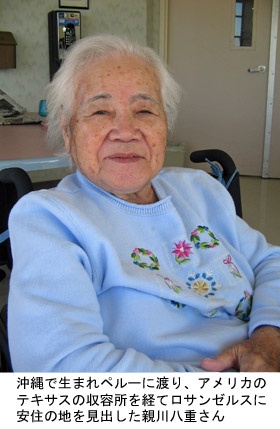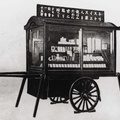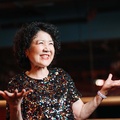Part 2 >>
Unlike Nakamatsu, who moved from Peru to the United States with her family at the age of four, Yae Oyagawa was already married during World War II and was helping out at the market in Lima run by her husband. Oyagawa was born in Okinawa in 1918. She had been living in Peru with her husband for several years. It was during her lunch break that her husband was taken away. Suddenly there was a knock on the door, and her husband and his brother's names were called. They were taken to the police station and never returned home.
Even after her husband disappeared, there was no word from the Peruvian government. "My family was very worried, but we assumed he had probably been taken to the United States. Perhaps because Peruvian newspapers were in collusion with the United States, they never wrote about the missing Japanese. I didn't have any children, so I was able to focus on working at the store. But then Peruvian officials came to the store and took all the sales money. They only gave me enough to cover the food expenses of my family. They even confiscated my checkbook."
Soon, she received a letter from her husband. It seemed that he had been sent from one internment camp to another in the United States. So, after consulting with her father-in-law, her husband's father, she decided to head to the United States with the remaining family. "We left everything in our store behind. At the time, Peru couldn't sew shirts or ties, so we sold items imported from Japan in our store. All of that was stolen by the government, too." Without looking back, Oyagawa's family boarded a ship at a port in Peru. "Everyone else, except for me, had been successful in business, but they left everything behind to board the ship. Some were owners of coffee shops, restaurants, and apartment buildings. I wonder what became of them in the United States. I don't know what happened to them after that."
They entered the port of New Orleans and took a train to the internment camp in Crystal City, Texas. There, she reunited with her husband for the first time in a year and savored the joy. After three years in the internment camp, the war ended. "There was talk of returning to Okinawa. But at that time, my father-in-law said that the Japanese had lost the war and were now struggling for food. Those who had returned from outside would suffer even more. We shouldn't return. In the end, we decided to move to Covina, a suburb of Los Angeles, California." Oyagawa's husband got a job as a gardener. Oyagawa herself worked as a dressmaker. The whole family lived in a supportive environment. Not only the family, but the people who came from Peru all helped each other, centering around a leader named Gongoro Nakamura. Oyagawa gave birth to a daughter, Lynn, in 1952.
I met Oyakogawa in the spring of 2006. Looking back on her nearly 90 years of life, she ended by saying, "When I went to Peru at the age of 19, I thought I would live there for the rest of my life. Since coming to the United States, I have never been back to Peru. I cannot forgive the Peruvian government. Why didn't I join the compensation movement? If someone like Nakamura had been alive, we might have been able to do something with the lawyers, with him at the center. But people like us couldn't do anything."
She still dreams about Peru. "There was a knock on the door and I woke up in shock. That was the moment that changed our family's lives forever."
It was shocking to hear Nakamatsu and Oyagawa say, "We have never spoken about our wartime deportation experiences to anyone other than our own family." The Japanese Peruvians who fell victim to the war had kept their unjust pasts to themselves and worked hard in America, a foreign country to them. Through this interview, I felt even more strongly that we must widely communicate the tragedies of the Japanese Peruvians.
(End)
© 2008 Keiko Fukuda











